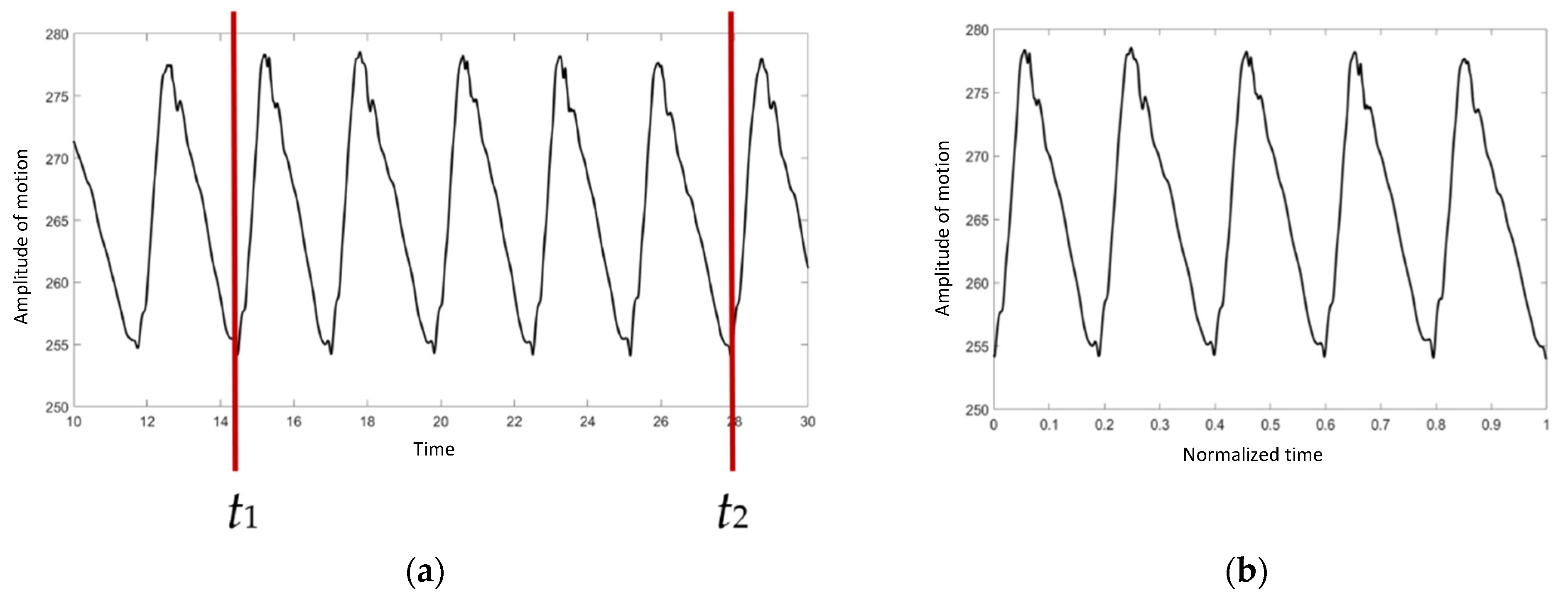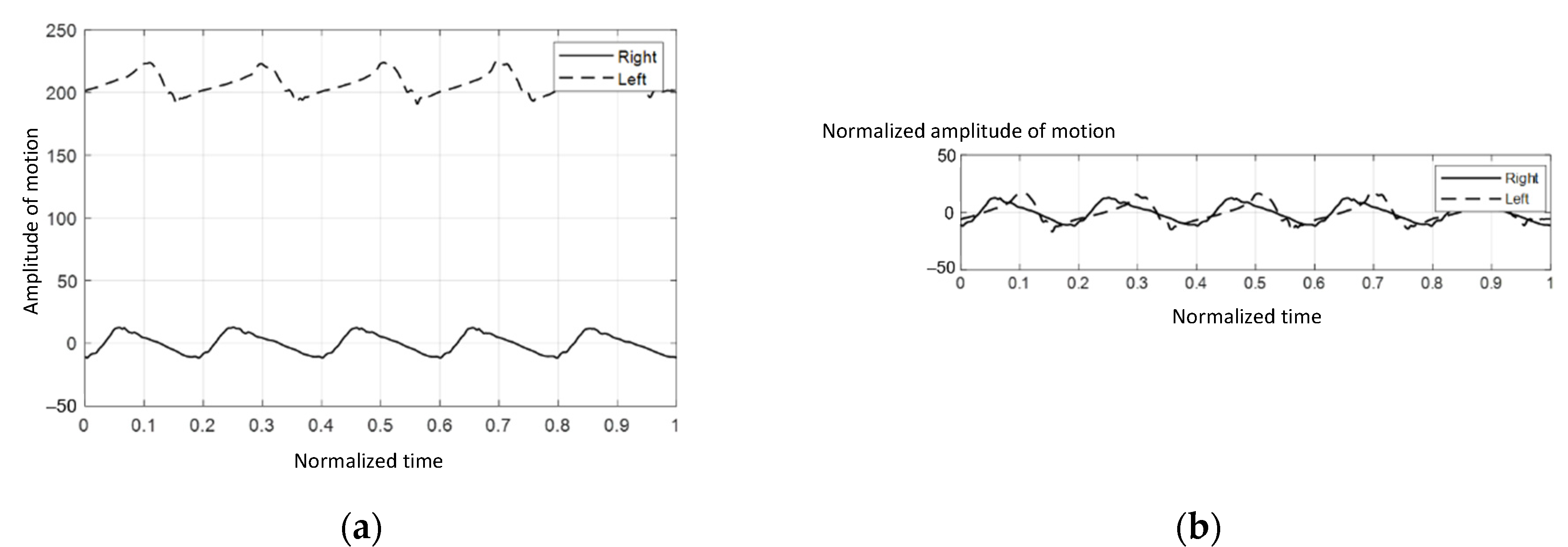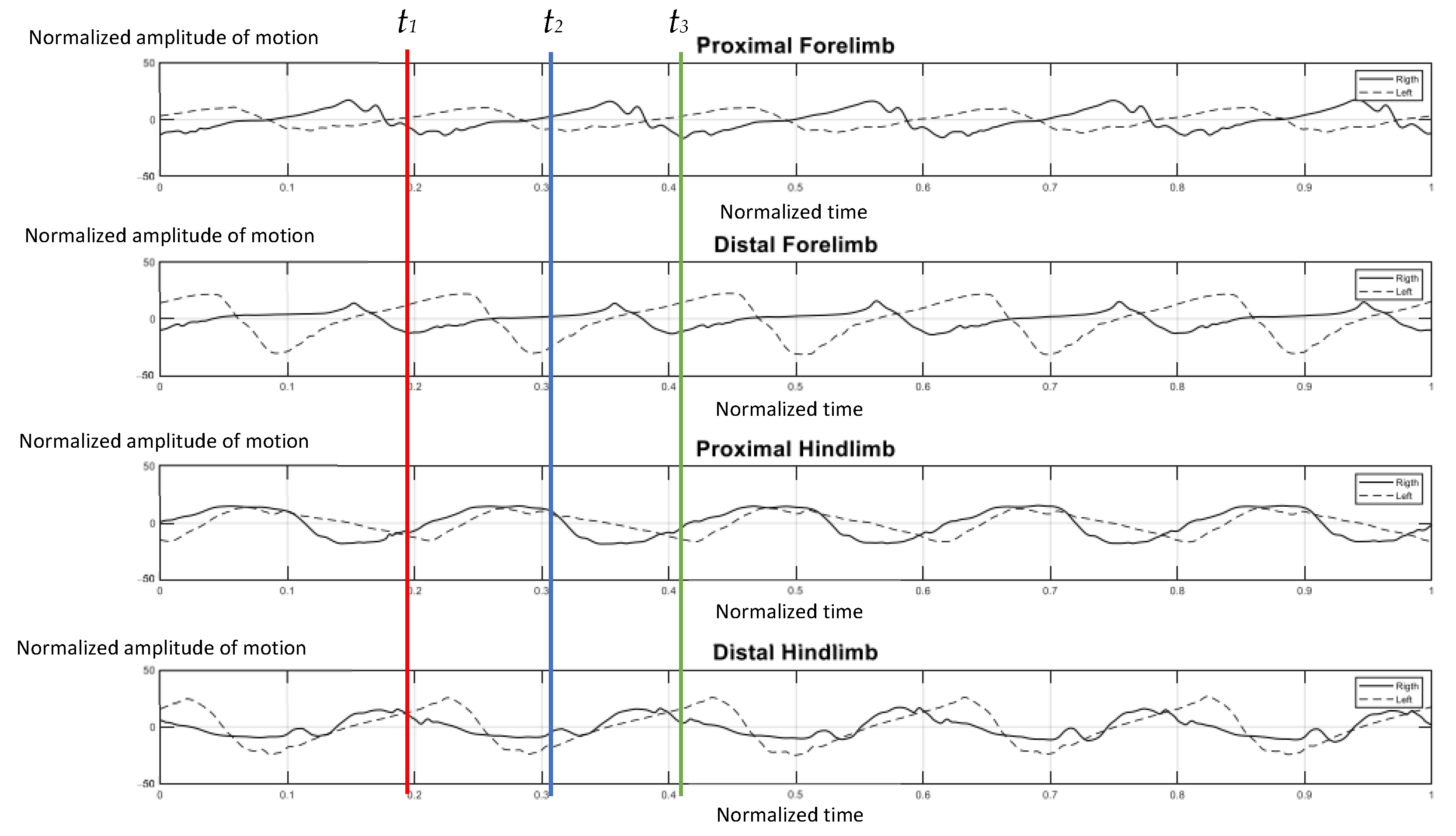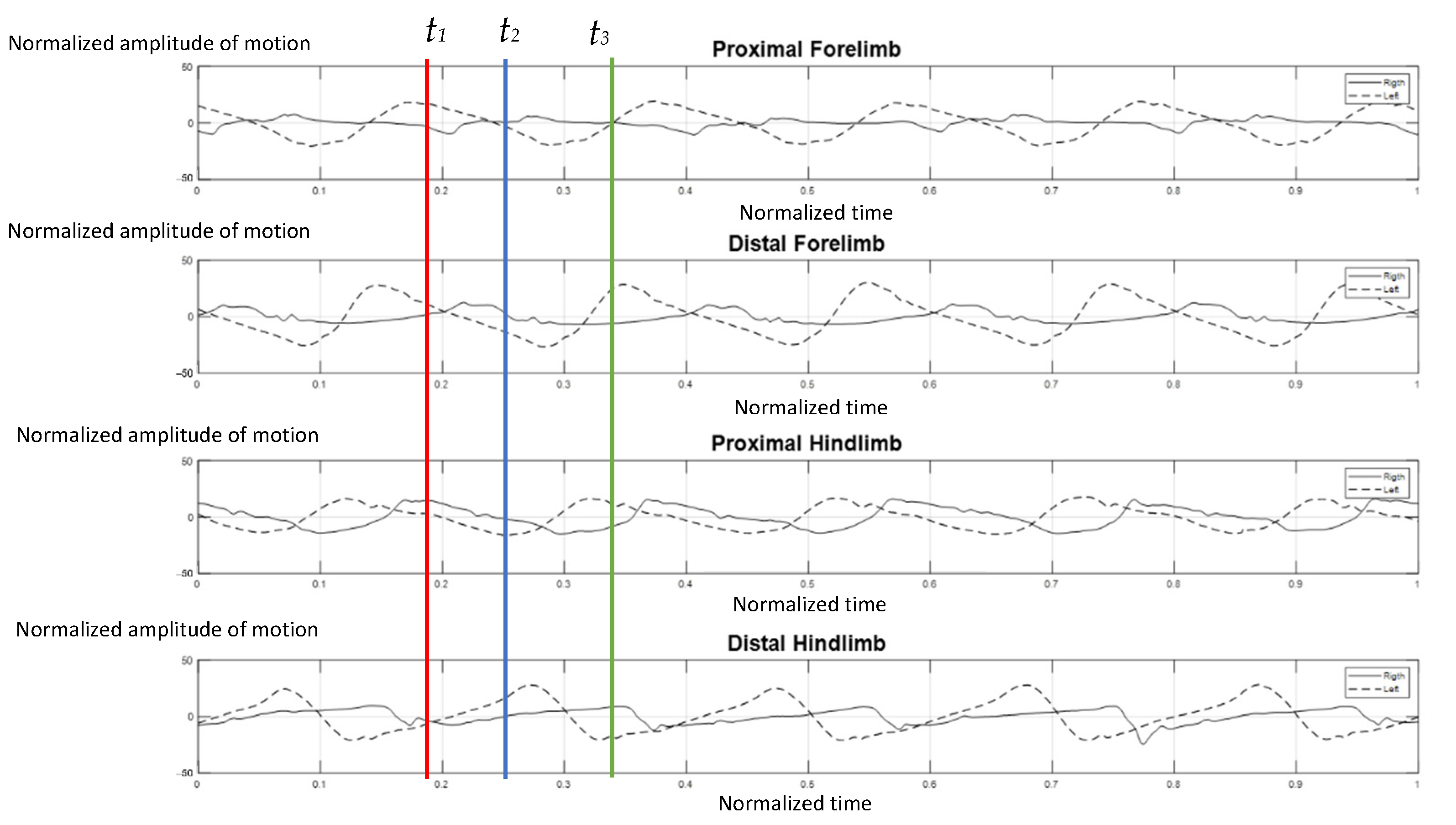Development of a Protocol for Biomechanical Gait Analysis in Asian Elephants Using the Triaxial Inertial Measurement Unit (IMU)
Abstract
:Simple Summary
Abstract
1. Introduction
2. Materials and Methods
2.1. Study Animals
2.2. Data Collection and Analysis
3. Results
4. Discussion
Author Contributions
Funding
Institutional Review Board Statement
Informed Consent Statement
Data Availability Statement
Acknowledgments
Conflicts of Interest
References
- Hutchinson, J.R.; Schwerda, D.; Famini, D.J.; Dale, R.H.I.; Fischer, M.S.; Kram, R. The locomotor kinematics of Asian and African elephants: Changes with speed and size. J. Exp. Biol. 2006, 209, 3812–3827. [Google Scholar] [CrossRef] [PubMed]
- Wijesooriya, P.N.; Abeykoon, A.H.S.; Udawatta, L.; Punchihewa, A.; Nanayakkara, T. Gait pattern analysis of an Asian elephant. In Proceedings of the 6th International Conference on Information and Automation for Sustainability (ICIAFS), Beijing, China, 27–29 September 2012; Institute of Electrical and Electronics Engineers: Beijing, China; pp. 221–226. [Google Scholar]
- Hutchinson, J.R. The evolutionary biomechanics of locomotor function in giant land animals. J. Exp. Biol. 2021, 224, jeb217463. [Google Scholar] [CrossRef]
- DeCamp, C.E. Kinetic and Kinematic Gait Analysis and the Assessment of Lameness in the Dog. Vet. Clin. N. Am. Small Anim. Pract. 1997, 27, 825–840. [Google Scholar] [CrossRef]
- Barrey, E. Methods, Applications and Limitations of Gait Analysis in Horses. Vet. J. 1999, 157, 7–22. [Google Scholar] [CrossRef] [PubMed]
- McLaughlin, R.M. Kinetic and Kinematic Gait Analysis in Dogs. Vet. Clin. N. Am. Small Anim. Pract. 2001, 31, 193–201. [Google Scholar] [CrossRef]
- Matsushita, Y.; Tran, D.T.; Yamazoe, H.; Lee, J.-H. Recent use of deep learning techniques in clinical applications based on gait: A survey. J. Comput. Des. Eng. 2021, 8, 1499–1532. [Google Scholar] [CrossRef]
- Hildebrand, M.; Hurley, J.P. Energy of the oscillating legs of a fast-moving cheetah, pronghorn, jackrabbit, and elephant. J. Morphol. 1985, 184, 23–31. [Google Scholar] [CrossRef] [PubMed]
- Hutchinson, J.R.; Famini, D.; Lair, R.; Kram, R. Biomechanics: Are fast-moving elephants really running? Nature 2003, 422, 493–494. [Google Scholar] [CrossRef] [PubMed]
- Ren, L.; Butler, M.; Miller, C.; Paxton, H.; Schwerda, D.; Fischer, M.S.; Hutchinson, J.R. The movements of limb segments and joints during locomotion in African and Asian elephants. J. Exp. Biol. 2008, 211 Pt 17, 2735–2751. [Google Scholar] [CrossRef]
- Ren, L.; Hutchinson, J. The three-dimensional locomotor dynamics of African (Loxodonta africana) and Asian (Elephas maximus) elephants reveal a smooth gait transition at moderate speed. J. R. Soc. Interface 2007, 5, 195–211. [Google Scholar] [CrossRef]
- Bell, R.P.; Reed, S.K.; Schoonover, M.J.; Whitfield, C.T.; Yonezawa, Y.; Maki, H.; Pai, P.F.; Keegan, K.G. Associations of force plate and body-mounted inertial sensor measurements for identification of hind limb lameness in horses. Am. J. Vet. Res. 2016, 77, 337–345. [Google Scholar] [CrossRef] [PubMed]
- Keegan, K.G.; Yonezawa, Y.; Pai, P.K.; Wilson, D.A.; Kramer, J. Evaluation of a sensor-based system of motion analysis for detection and quantification of forelimb and hind limb lameness in horses. Am. J. Vet. Res. 2004, 65, 665–670. [Google Scholar] [CrossRef] [PubMed]
- Pálya, Z.; Rácz, K.; Nagymáté, G.; Kiss, R.M. Development of a detailed canine gait analysis method for evaluating harnesses: A pilot study. PLoS ONE 2022, 17, e0264299. [Google Scholar] [CrossRef] [PubMed]
- Bonato, P. Advances in wearable technology and applications in physical medicine and rehabilitation. J. Neuroeng. Rehabil. 2005, 2, 2. [Google Scholar] [CrossRef] [PubMed]
- Ahmad, N.; Ghazilla, R.A.R.; Khairi, N.M.; Kasi, V. Reviews on Various Inertial Measurement Unit (IMU) Sensor Applications. Int. J. Signal Process. Syst. 2013, 1, 256–262. [Google Scholar] [CrossRef]
- Hindle, B.; Keogh, J.; Lorimer, A.V. Inertial-Based Human Motion Capture: A Technical Summary of Current Processing Methodologies for Spatiotemporal and Kinematic Measures. Appl. Bionics Biomech. 2021, 2021, 6628320. [Google Scholar] [CrossRef] [PubMed]
- Kongsawasdi, S.; Wantanajittikul, K.; Langkaphin, W.; Chuatrakoon, B.; Namwongprom, K.; Prupetkaew, P.; Angkawanish, T. Optimal Management to Improve Quality of Life for an Injured Baby Elephant: Thailand Multidisciplinary Care Team. Kafkas Univ. Vet. Fak. Derg. 2021, 27, 655–659. [Google Scholar] [CrossRef]
- Genin, J.J.; Willems, P.A.; Cavagna, G.A.; Lair, R.; Heglund, N.C. Biomechanics of locomotion in Asian elephants. J. Exp. Biol. 2010, 213, 694–706. [Google Scholar] [CrossRef] [PubMed]
- Kongsawasdi, S.; Mahasawangkul, S.; Pongsopawijit, P.; Boonprasert, K.; Chuatrakoon, B.; Thonglorm, N.; Kanta-In, R.; Tajarernmuang, T.; Nganvongpanit, K. Biomechanical Parameters of Asian Elephant (Elephas maximus) Walking Gait. Kafkas Univ. Vet. Fak. Derg. 2017, 23, 357–362. [Google Scholar] [CrossRef]






Publisher’s Note: MDPI stays neutral with regard to jurisdictional claims in published maps and institutional affiliations. |
© 2022 by the authors. Licensee MDPI, Basel, Switzerland. This article is an open access article distributed under the terms and conditions of the Creative Commons Attribution (CC BY) license (https://creativecommons.org/licenses/by/4.0/).
Share and Cite
Wantanajittikul, K.; Thitaram, C.; Khammesri, S.; Kongsawasdi, S. Development of a Protocol for Biomechanical Gait Analysis in Asian Elephants Using the Triaxial Inertial Measurement Unit (IMU). Vet. Sci. 2022, 9, 432. https://doi.org/10.3390/vetsci9080432
Wantanajittikul K, Thitaram C, Khammesri S, Kongsawasdi S. Development of a Protocol for Biomechanical Gait Analysis in Asian Elephants Using the Triaxial Inertial Measurement Unit (IMU). Veterinary Sciences. 2022; 9(8):432. https://doi.org/10.3390/vetsci9080432
Chicago/Turabian StyleWantanajittikul, Kittichai, Chatchote Thitaram, Siripat Khammesri, and Siriphan Kongsawasdi. 2022. "Development of a Protocol for Biomechanical Gait Analysis in Asian Elephants Using the Triaxial Inertial Measurement Unit (IMU)" Veterinary Sciences 9, no. 8: 432. https://doi.org/10.3390/vetsci9080432






